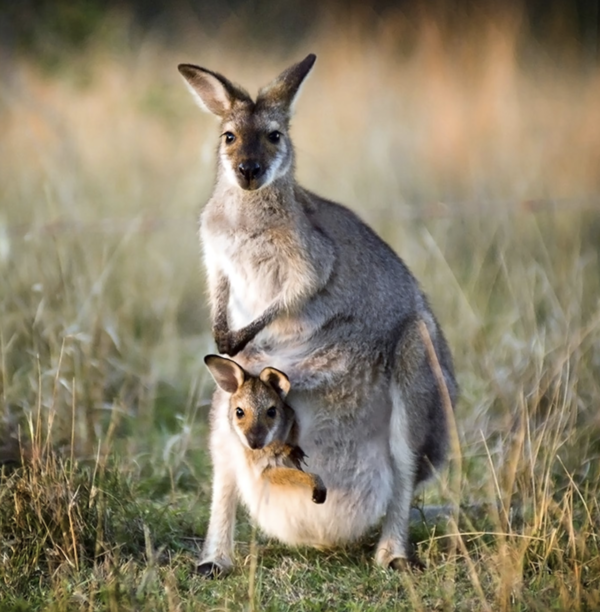Kangaroos are one of Australia's most iconic marsupials, known for their powerful hind legs, long tails, and, most notably, pouches. But do all kangaroos have pouches? This question sparks curiosity, especially among those interested in marsupial biology, zoology, and evolutionary adaptations. In this article, we will explore the anatomy, function, and evolution of the kangaroo pouch, differences between male and female kangaroos, and how this feature benefits their survival.

A pouch, scientifically known as a marsupium, is a specialized external fold of skin that functions as a protective and nurturing space for developing young. It is an essential part of marsupial reproduction and differs significantly from the placental reproductive system found in most mammals.
Located on the lower abdomen of female kangaroos
Opens forward, allowing easy access for the joey
Contains mammary glands that produce different types of milk depending on the joey’s age
Muscular and flexible, capable of expanding and contracting
Maintained with natural antimicrobial substances to keep the joey safe
The pouch is an evolutionary adaptation that allows marsupials to give birth to underdeveloped offspring, which continue developing outside the womb but inside this protected space.
The simple answer is no—only female kangaroos have pouches.
All female kangaroos, regardless of species, have a well-developed pouch. This structure is critical for the survival of their young, known as joeys. Since kangaroos give birth to extremely underdeveloped babies, the pouch acts as a second womb, where the joey can continue growing in a secure and nourishing environment.
Male kangaroos do not have pouches. Unlike some other species where both sexes may develop similar anatomical features, in kangaroos, the pouch is exclusive to females because it serves a maternal function.
Why don’t male kangaroos have pouches?
Males do not carry offspring, so a pouch would have no biological function
Evolutionarily, males invest in competition for mates rather than parental care
The absence of a pouch allows males to develop a more muscular build, which aids in dominance and mating battles
Not all marsupials have pouches, and in some species, both males and females may develop them to varying degrees. Below is a comparison:
| Marsupial Species | Do Females Have Pouches? | Do Males Have Pouches? | Pouch Orientation & Features |
|---|---|---|---|
| Red Kangaroo (Macropus rufus) | ✅ Yes | ❌ No | Forward-facing, deep, and muscular |
| Eastern Grey Kangaroo (Macropus giganteus) | ✅ Yes | ❌ No | Large and forward-facing |
| Wallaby (Macropus spp.) | ✅ Yes | ❌ No | Similar to kangaroos but smaller |
| Koala (Phascolarctos cinereus) | ✅ Yes | ❌ No | Downward-facing pouch to prevent debris entry |
| Wombat (Vombatus ursinus) | ✅ Yes | ❌ No | Backward-facing pouch to avoid soil entering while digging |
| Tasmanian Devil (Sarcophilus harrisii) | ✅ Yes | ❌ No | Four nipples inside pouch, shallow structure |
| Water Opossum (Chironectes minimus) | ✅ Yes | ✅ Yes | One of the few marsupials where males have a rudimentary pouch for testicular protection |
As seen in the table, most marsupials do not have male pouches, but there are rare exceptions, such as the water opossum, where males use a pouch for a different function.
The reproductive strategy of kangaroos is highly unique compared to placental mammals.
Gestation Period: About 33 days, significantly shorter than placental mammals.
Birth of Joey: A tiny, pink, bean-sized joey (about 2 cm long) is born and instinctively crawls into the pouch.
Attachment to the Nipple: The joey latches onto a mammary gland, where it remains attached for several months.
Growth in the Pouch: The joey stays inside for 6-9 months, developing fur and growing strong.
Emergence and Weaning: It begins exploring outside the pouch while still returning for milk. Full independence occurs at around 12-18 months.
Fun Fact: Female kangaroos can produce two types of milk simultaneously for joeys of different ages!
The marsupial reproductive strategy is a unique evolutionary adaptation that differs from placental mammals.
✅ Shorter gestation reduces risks of maternal death during pregnancy
✅ Protection of young from predators in an external "womb"
✅ Ability to pause pregnancy (Embryonic Diapause) if resources are scarce
✅ Flexibility in offspring rearing, allowing multiple joeys at different stages
This system has allowed marsupials to thrive in harsh Australian environments, where food and water can be unpredictable.
To sum up:
Only female kangaroos have pouches—males do not develop them.
The pouch is crucial for reproductive success, as it serves as an external womb for developing joeys.
Not all marsupials have pouches, and some have variations (e.g., wombats with backward-facing pouches).
The evolution of the pouch gives kangaroos an advantage in their environment, allowing flexible reproduction and protection of their young.
Understanding the unique biology of kangaroos helps us appreciate how these incredible marsupials have adapted over millions of years.
Did you find this information fascinating? Share your thoughts and questions in the comments!
animal tags: Macropodidae
We created this article in conjunction with AI technology, then made sure it was fact-checked and edited by a Animals Top editor.